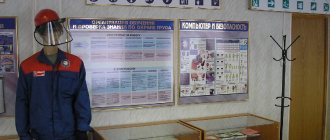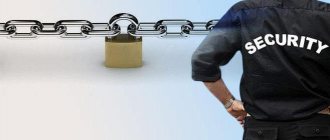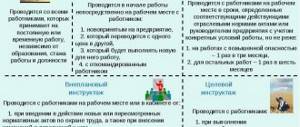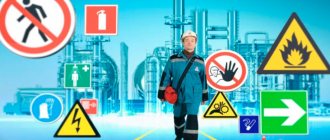Enterprise safety
From this article you will learn how occupational health and safety at work is organized, who is responsible for the safety of workers, why an occupational safety service is created at an enterprise, how it works and who controls it.
Occupational health and safety at an enterprise is a set of measures necessary to protect workers while performing tasks assigned by the employer. According to their areas of work, they are divided into:
• ensuring the safety of electrical equipment, cable lines, power lines, lightning protection; • protection from fires, fires and smoke; • safe organization of all categories of work; • maintaining the serviceability of equipment (verification, repair, timely replacement); • maintaining buildings for various purposes, structures, structures, as well as the territory in proper condition; • neutralizing the impact of noise, dust, vibration and other harmful factors on workers; • protection of people who work in dangerous conditions: at heights, underground, in conditions of high or low temperatures, various radiations, in contact with hot or moving objects and their parts, etc.; • training of workers, students, management personnel (instructions on labor protection and safety, special courses, posters, diagrams, drawings, etc.); • monitoring of health indicators of workers (preliminary, pre-shift, annual, extraordinary medical examinations and examinations), organization of sanatorium treatment, provision of therapeutic and preventive food, milk; • public monitoring of the organization of occupational health and safety at the enterprise: the work of occupational safety officers, trade unions, and other public associations.
Taking into account the requirements of regulatory documentation that regulates the activities of specific organizations, they develop their own OSH standards. All the information employees need on the safe conduct of work is set out in the occupational health and safety instructions for specific professions or the performance of certain work (loading and unloading, fire, etc.).
Hiring procedure: step-by-step algorithm
Hiring is a standard procedure faced by all employers who have at least one employee on staff.
However, there are pitfalls here too: for example, in relation to some categories of workers, additional actions need to be taken. In order to minimize all risks for the company, we will analyze what blocks the hiring procedure consists of and exactly how to act in different situations. Block No. 1. Obtaining from the employee the necessary documents and consent to the processing of personal data
To conclude an employment contract, the employee must provide the employer with the necessary set of documents, which are established by Article 65 of the Labor Code of the Russian Federation. Such documents include: - passport or other identification document; — work record book and (or) information about work activity, except for cases where the employment contract is concluded for the first time; — a document confirming registration in the individual (personalized) accounting system, including in the form of an electronic document; — military registration documents (for those liable for military service and persons subject to conscription for military service); - a document on education and (or) qualifications or the presence of special knowledge - when applying for a job that requires special knowledge or special training; - a certificate of the presence (absence) of a criminal record and (or) the fact of criminal prosecution or the termination of criminal prosecution - when applying for a job related to activities to which persons who have or have had a criminal record, are or have been subject to criminal prosecution are not allowed; - a certificate stating whether or not a person is subject to administrative punishment for the consumption of narcotic drugs or psychotropic substances without a doctor’s prescription or new potentially dangerous psychoactive substances - when applying for work related to activities that are not permitted to persons subject to administrative punishment for consumption of narcotic drugs or psychotropic substances.
Additional documents may be required for certain categories of employees. For example, when applying for a job, a foreign citizen will be required to have a document that allows them to carry out work activities on the territory of the Russian Federation (for example, a patent or work permit).
Having received the work book from the employee, the employer is obliged to make an appropriate note in the book of registration of the movement of work books and inserts in them.
When an employee provides the company with the documents necessary for employment, the employer begins processing his personal data. In some cases, this requires obtaining consent from the employee to process his personal data.
Block No. 2. Checking whether an employee is disqualified
This block is not relevant for all employees, but only for the leaders of the organization. Before concluding an employment contract with a manager, you must make sure that he has not been brought to administrative liability, which would preclude the possibility of holding such a position (has not been disqualified). To do this, you should refer to the register of disqualified persons maintained by the Federal Tax Service.
As follows from Part 3 of Art. 32.11 of the Code of Administrative Offenses of the Russian Federation, the information contained in the register is open for review. There is no fee for access to information contained in the register of disqualified persons posted by the authorized federal executive body on its official website. But there is a fee for obtaining an extract from the register about a specific disqualified person or a certificate confirming the absence of the requested information. The amount of the fee is established by paragraph 1 of the Decree of the Government of the Russian Federation dated July 3, 2014 No. 615 “On establishing the amount of the fee for providing information from the register of disqualified persons, as well as on amending and invalidating certain acts of the Government of the Russian Federation” and is 100 rubles.
The period for providing an extract or certificate cannot exceed 5 working days from the date of receipt of the relevant request. The procedure for obtaining statements and certificates is established by Order of the Federal Tax Service of Russia dated December 10, 2019 No. ММВ-7-14/ [email protected]
Block No. 3. Conducting a preliminary medical examination and psychiatric examination
This block also applies only to those employees who enter certain types of work or under appropriate working conditions.
For example, in accordance with Part 1 of Article 213 of the Labor Code of the Russian Federation, workers engaged in work with harmful and (or) dangerous working conditions (including underground work), as well as in work related to traffic, undergo mandatory preliminary (upon entry to work) medical examinations to determine the suitability of these workers to perform the assigned work and prevent occupational diseases.
To determine the categories of workers for whom periodic medical examination is mandatory, as well as to understand the procedure for undergoing medical examinations, you must refer to Order of the Ministry of Health and Social Development of Russia dated April 12, 2011 No. 302n.
The same is true with a psychiatric examination: when hiring, it is necessary to check its availability if it is a condition for the employee’s admission to work. The rules for passing such an examination are established by Decree of the Government of the Russian Federation dated September 23, 2002 No. 695. The types and lists of work for which the survey is carried out are listed in Decree of the Government of the Russian Federation dated April 28, 1993 No. 377.
Block No. 4. Familiarization of the employee with local regulations against signature
This block is required for all employees. Before signing an employment contract, the employee must be familiar with all local regulations of the organization that relate to his work, and with the collective agreement.
Familiarization with the employer's local regulations can be done in familiarization sheets for each act or on a separate familiarization sheet indicating all local regulations that the employee is familiar with.
Block No. 5. Registration of an employment contract
The employment contract is concluded in writing, drawn up in two copies, each of which is signed by the parties. One copy of the employment contract is given to the employee, the other is kept by the employer. The employee’s receipt of a copy of the employment contract must be confirmed by the employee’s signature on the copy of the employment contract kept by the employer.
An employment contract that is not formalized in writing is considered concluded if the employee began work with the knowledge or on behalf of the employer or his authorized representative. The employer is obliged to draw up an employment contract with the employee in writing no later than three working days from the date the employee is actually allowed to work.
Please note that the law does not define the actual permission of an employee to work, so in order to minimize risks and disputes with employees, it is recommended to enshrine this definition in local regulations.
It is especially important that the content of the employment contract strictly complies with the requirements of Article 57 of the Labor Code of the Russian Federation.
Block No. 6. Registration of an order for employment
Hiring is formalized by an order (instruction) of the employer, issued on the basis of a concluded employment contract. The contents of the order must comply with the terms of the employment contract. The employer has the right to use both a unified order form and approve his own.
The employer's order (instruction) regarding employment is announced to the employee against signature within three days from the date of actual start of work. But in practice, as a rule, the order is issued on the day the employment contract is signed.
Block No. 7. Providing information to the Russian Pension Fund
From April 28, 2021, in cases of hiring and dismissal of a registered person (an individual for whom an individual personal account has been opened in the individual (personalized) accounting system), it is necessary to submit information to the Pension Fund of the Russian Federation in the form SZV-TD no later than the working day following the day of publication relevant order (instruction), other decisions or documents confirming the formalization of labor relations.
Block No. 8. Conducting initial and introductory briefings
Before starting independent work, the employee must undergo introductory and initial briefings. Introductory training is carried out for all hired employees after signing an employment contract. This is done by a labor protection specialist or an employee who has been assigned these responsibilities by order of the employer (or a person authorized by him). The result of the introductory briefing is recorded in the appropriate journal.
Initial instruction is carried out before the start of independent work by the immediate supervisor. Workers not involved in the operation, maintenance, testing, adjustment and repair of equipment, the use of electrified or other tools, the storage and use of raw materials and materials may be exempt from undergoing initial training at the workplace. The list of professions and positions of employees exempt from undergoing initial training at the workplace is approved by the employer (Resolution of the Ministry of Labor of Russia, Ministry of Education of Russia dated January 13, 2003 No. 1/29 “On approval of the Procedure for training in labor protection and testing knowledge of labor protection requirements for employees of organizations”) .
Block No. 9. Mark on admission to work in the time sheet
The fact of starting work must be reflected in the timesheet with the appropriate code (depending on the form of the timesheet or other document used to record working time).
Block No. 10. Registration of a personal T-2 card
At this stage, it is necessary to fill out the T-2 card, including the section on military registration. Section 3 “Hiring and transfers to another job” is not completed.
Block No. 11. Making an entry in the work book
The employer keeps work books for each employee who has worked for him for more than five days, in the case where the work for this employer is the main one for the employee. In other words, the employer makes a record of hiring in the work book on the 6th working day (but the start date of work is indicated).
This is relevant if the work record book continues to be kept on paper.
Here's an example of an entry:
Why do you need to follow safety precautions in the workplace?
The answer is obvious: “So as not to get injured.” But there are other reasons.
So, 5 reasons why you need to observe safety precautions in the workplace:
1. So that the employee remains alive, healthy and does not become disabled. Think about it, about 2,000 people die a year at Russian enterprises and about 4,000 people become disabled per year!
2. Causing damage to the health of other employees. For causing harm to the health of citizens, both administrative liability is provided (Article 5.27 of the Administrative Code) and criminal liability (Article 143 of the Criminal Code of the Russian Federation).
3. Failure to provide various benefits and guarantees not provided for by the collective agreement. Thus, many enterprises do not pay the 13th salary to violators of labor discipline.
4. Decrease in the quality of products and services.
5. Dismissal at the initiative of the employer. The administration of the enterprise has every right to terminate an employment contract for repeated violations of safety regulations or for a single gross violation of safety regulations (Articles 81 and 192 of the Labor Code of the Russian Federation).
Who is responsible for worker safety?
Among workers who are superficially familiar with occupational safety requirements, there is an opinion that the occupational safety and health engineer is responsible for their safety. Actually this is not true. Their immediate supervisor is responsible for the safety of specific employees. Managers of enterprises, divisions, departments, etc. are generally responsible for occupational health and safety at work.
Responsibility for compliance with occupational health and safety requirements at the enterprise is also divided into areas of supervision and assigned to employees of appropriate competence. For example, energy service employees appointed by orders are responsible for electrical safety; immediate supervisors are responsible for organizing a system of briefings on labor protection and safety at workplaces and its quality functioning.
The workers themselves are obliged to take care of their own safety. This is a requirement not only of common sense, but also of Art. 214 Labor Code of the Russian Federation. To stay healthy and work, workers need to:
• clearly know and constantly comply with the requirements of safety and labor protection instructions; • complete training and medical examinations on time; • use PPE; • be able to provide first aid; • carefully monitor the environment, analyze production situations and immediately report to the work manager about possible or existing dangers.
During training, medical examination, or work stoppage due to a dangerous situation, the worker retains his average earnings. If he evades responsibility for his own health - does not attend instructions on occupational health and safety, does not undergo medical examinations, regularly violates occupational safety requirements - the employer’s representatives have the right to remove him from work in the appropriate manner. However, no wages are accrued during this time.
Requirements before starting work
There are several types of briefings.
A person undergoes the following before direct employment:
- medical examination. This is necessary to determine his state of health at the time of employment. To determine the criteria for these indicators, there is a regulatory document developed by the Ministry of Health - this is order No. 302-N.
Its contents indicate the main reasons for the health of the future employee, according to which he cannot work in this workplace, as well as a list of harmful factors and types of work with contraindications for health reasons.
This is, first of all, necessary for the employer, that is, the manager is not responsible if a future employee has a pathology, since specialists have issued a conclusion that the person can work;
- conducting briefings:
- Introductory. Conducted before arrival at the workplace. The purpose of its implementation is to convey to people the main dangers existing at the enterprise, including how to avoid them. As a rule, it is carried out by a specialist from the labor protection service. The training is recorded with the signatures of two parties: the specialist and the future employee, and the date of completion is indicated next to it;
- Primary. Conducted before the actual execution of a production task for the first time. The employee saw his workplace for the first time and his supervisor must provide him with detailed information about what needs to be done and how to avoid possible accidents. In a special journal, the signatures of the employee and the employer are affixed with the obligatory date;
- familiarization of the employee with the special assessment card of working conditions. SOUT is carried out by an independent expert organization that has the right to engage in this type of activity. This document contains information:
- Characteristics of the production process and description of the workplace;
- Hazards present at the site;
- The presence and excess of harmful factors, including gas and dust levels;
- What benefits are available when performing work duties at this workplace;
- Frequency of medical examinations;
- What personal protective equipment should be used;
- Instrumental assessment of working conditions;
- familiarization with job responsibilities against signature.
OHS is carried out by experts to realistically assess the safety of the workplace.
The employee must be familiarized with this document against signature so that he has an understanding of his rights and responsibilities.
What is the occupational safety service responsible for?
The area of responsibility of the occupational safety service, which can be represented even by a single engineer, is the organization of occupational health and safety at the enterprise. Representatives of this service are obliged to:
1. Organize an investigation, recording of NS, PP, analysis of the causes of their occurrence, development of preventive measures;
2. Create and implement programs and activities to improve the quality of working conditions;
3. Provide organizational and methodological support to departments in the field of occupational safety: help develop instructions on safety and labor protection, store their control copies, provide departments and management employees with instructions, magazines, cards, other documentation on occupational safety, visual aids, rules, regulations;
4. Participate in testing workers’ knowledge based on the results of occupational safety training conducted by the enterprise;
5. Help prepare any documents that relate to labor protection and safety at work: collective agreement, various agreements, orders for calls to work on weekends, changes in schedule, etc.;
6. Help make lists for:
• passing pre-shift, preliminary and annual medical examinations; • receiving milk, special food; • issuance of protective clothing and personal protective equipment; • receiving compensation (preferential pension provision, additional leave);
7. Prepare and submit labor safety reports;
8. Store OT documentation;
9. Organize training on occupational safety for employees and managers;
10. Regularly check the health status in departments;
11. Conduct introductory briefings on labor protection and safety precautions.
In order to effectively monitor compliance with occupational health and safety requirements at work, occupational safety specialists can at any time:
• inspect machinery, equipment, premises; • check occupational safety documentation (keeping logs, familiarizing workers with occupational health and safety instructions, maintaining workwear and personal protective equipment accounting cards, issuing work permits, etc.), the availability of personal protective equipment and their actual use; • monitor the use of safe practices and work methods by workers.
In order to successfully carry out the tasks assigned to them, occupational safety specialists cooperate with other services of the enterprise (human resources, power engineers, mechanics, first aid station, etc.), as well as the occupational safety commission, employees’ representatives on occupational safety issues, and the trade union.
OCCUPATIONAL SAFETY REQUIREMENTS IN EMERGENCIES
4.1. In the event of an emergency, the employee is obliged to: - immediately stop work, disconnect office equipment and other electrical equipment from the power supply network and report the occurrence of an emergency and its nature to the immediate supervisor, and in his absence, to the senior manager; if necessary, leave the danger zone; — under the leadership of the immediate supervisor, take part in eliminating the emergency situation, if this does not pose a threat to the health or life of workers; - in the event of malfunctions in the operation of office equipment or other equipment, as well as in the event of disturbances in the operation of the electrical network (burning smell, extraneous noise when operating office equipment and other equipment, or the sensation of electric current when touching their cases, flashing lamps, etc.); d.) disconnect office equipment and other equipment from the power supply, call technical personnel and inform your immediate supervisor about this; - in case of detection of malfunctions of furniture and fixtures, stop using them, call technical personnel and report this to your immediate supervisor; — in the event of a temporary interruption of power supply, disconnect office equipment and other electrical equipment from the power supply network; - do not start work until damage and malfunctions of office equipment and workplace equipment are completely eliminated or the emergency situation is eliminated; - if a fire occurs, it is necessary to stop work, call the fire brigade, disconnect office equipment and other equipment from the power supply, notify nearby people about the fire, take measures to evacuate people from the danger zone and take part in extinguishing the fire using the available primary fire extinguishing means, and if impossible extinguish the fire and leave the danger zone, acting in accordance with fire safety instructions and evacuation plans; — extinguish a fire using powder or carbon dioxide fire extinguishers with the mandatory use of personal protective equipment; - in case of accidents with other employees, provide first aid to the victim, help transport him to a health center or the nearest medical facility, and, if necessary, call medical workers to the scene of the incident; - immediately inform your immediate supervisor about an accident that happened to an employee or through his fault, as well as about any accident involving other employees of your own or a third-party organization, which was witnessed by the employee; — take measures to preserve the situation of the accident, if this does not involve a danger to the life and health of people; — when investigating an accident, the employee must report all the circumstances of the incident known to him; — in the event of terrorist acts or the threat of their commission, act in accordance with emergency safety recommendations in force in the organization; — in the event of detection of violations of labor safety requirements in the office premises that cannot be eliminated on their own, as well as in the event of a threat to the life or health of the employee or other employees, inform your immediate supervisor, suspend work and leave the danger zone.
Instructions from safety service specialists
The Occupational Safety and Health Service monitors the safety of all types of work carried out at the enterprise. Safety engineers have the right to stop any work that is carried out in violation of the requirements of safety and labor protection instructions. At the same time, they issue orders that reflect the essence of the violations and indicate the time frame for their elimination. Ignoring the requirements of these orders by the persons to whom they were issued entails disciplinary, financial, and in especially severe cases, criminal liability.
The order includes: • the essence of the identified violations of the requirements of the rules, safety and labor protection instructions; • links to regulatory documentation, the requirements of which were violated; • time frame within which violations must be eliminated; • persons responsible for eliminating identified violations.
The order is issued to the work manager and is drawn up in 2 copies, one of which is issued to him against signature. If the work manager refuses to accept the order, a report about this is drawn up or the note “Refused to accept the order” is made on the order. If the order is refused, work is still stopped, and any violations identified must be corrected. The inspector may insist on conducting an unscheduled briefing on occupational health and safety instructions whose requirements have been violated.
As soon as the violations are eliminated, the responsible person informs the Occupational Health Service in writing. After the safety engineer checks the implementation of the necessary measures and makes the appropriate mark (+ date, signature) in the order, work can continue. Prescriptions are stored in the OT service. The order of their storage in the organization's divisions is established independently. For example, you can enter information about issued orders (the essence of violations, deadlines for elimination, responsible persons) in the occupational safety inspection logs.
Responsibility for violation of occupational safety requirements
The employer is responsible.
Any organization and industry has its own local regulations; in their absence, it is necessary to be guided by the regulatory documentation of the Russian Federation. Ignorance of the Rules does not affect the release from liability. In this case, the employer is responsible for:
- Lack of control in the field of occupational safety at the enterprise;
- Saving money on OSH;
- Failure to provide the employee with personal protective equipment;
- Lack of information and false information about the operation of equipment and unreliable information about the technological process;
- Saving money aimed at improving working conditions.
- Late training;
- Referring an employee to another job if he does not have certification;
- Concealment of accidents and occupational diseases.
The employer is obliged to comply with the requirements of labor legislation, otherwise he will be held liable, depending on the severity of the incident: material, disciplinary or criminal.
When violations are detected in the workplace, it is strongly recommended that they be recorded in writing so that there is legal confirmation of the fact of the violation. Afterwards, it is necessary to clearly monitor the implementation of these activities.
The employee's responsibility is to:
- employer requirements;
- use of PPE and work clothes when performing work duties;
- undergoing training;
- timely completion of medical examinations. In the absence of this data, the employer is obliged not to allow further work to be performed;
- work should only be performed that is assigned by the manager: in writing or orally;
- You cannot visit hazardous production areas at the enterprise if they are not within the scope of activity.
An employee must know his rights and obligations, and if he suspects a danger, immediately report this fact to his manager.
Can a Health and Safety Engineer work part-time?
The Labor Code obliges the employer to create the position of safety engineer or an entire service if his enterprise has 50 or more employees. If there are fewer of them, the employer is allowed:
• introduce the position of occupational safety and health engineer or create a corresponding service; • do this work independently; • assign these responsibilities to another employee (the employee must have education in labor protection in accordance with the professional standard); • involve a third-party specialist.
At the same time, the employer determines the amount of time allotted to the safety engineer to perform his work independently and records this in the staffing table. Therefore, it is not prohibited for a health and safety engineer to work part-time, part-week, or part-time. To optimize calculations of the load that is planned to be assigned to one person, it is advisable to use inter-industry standards for the number of workers in the occupational safety service developed by the Ministry of Labor of the Russian Federation. This is a document of a recommendatory nature.











